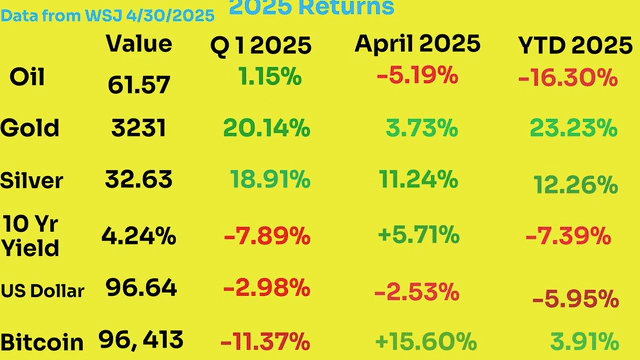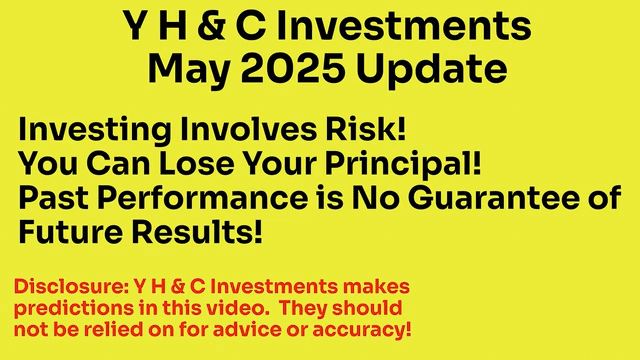Y H & C Investments- Slugging Percentage Is Crucial In Portfolio Management
(Return figures come from the April 30, 2025, edition of the Wall St. Journal. Y H & C Investments may have positions in companies mentioned in this newsletter. Nothing in the newsletter should be taken as an offer to buy or sell individual securities. It is the responsibility of each investor to research the investments mentioned so they can decide on the appropriateness and suitability of the investments consistent with their risk tolerance, risk constraints, and return objectives)
Growing up in Las Vegas, I was a massive Los Angeles Dodger fan. My twin brother, on the other hand, loved the New York Yankees. In the fall of 1977, when I was ten years old, the Los Angeles Dodgers played the New York Yankees in the World Series. It was highly anticipated, as the Yankees roared back in September after being a long way behind the Red Sox earlier in the summer. I believe they were 13 games back late in August. Jackson famously is quoted as saying, "I'm the straw that stirs the drink", meaning he was the key ingredient for the team’s success. Well, Reggie was right, as he hit three home runs in the deciding game six of that World Series. Interestingly, the next year the Yankees again defeated my Dodgers and Jackson again was the key player in the Yankees success. Why do I bring this up?
Like baseball, investing success is often more attributable to slugging percentage than batting average. In baseball, a big three run home run often changes the nature of a game. With investing, how much you make when you are correct with an investment has a far larger impact on your portfolio than almost anything you do. Stanley Druckenmiller, one of the best investors who ever lived, says it like this; “I'm here to tell you I was a pig. And I strongly believe the only way to make long-term returns in our business that are superior is by being a pig. I think diversification and all the stuff they're teaching at business school today is probably the most misguided concept everywhere.” “The mistake I'd say 98 percent of money managers and individuals make is they feel like they got to be playing in a bunch of stuff”.
Isn’t that revealing? Conventional portfolio management stresses diversification and not putting too many assets into one position. The biggest proponent of concentration is Charlie Munger:
‘The idea of diversification makes sense to a point. If you don’t know what you’re doing and you want the standard result and not be embarrassed, why, of course, you can widely diversify. Nobody’s entitled to a lot of money for recognizing that because it’s a truism. It’s like knowing that two and two equals four. But the investment professionals think they’re helping you by arranging diversification. An idiot can diversify a portfolio or a computer for that matter.
But the whole trick of the game is to have a few times when you know that something is better than average and invest only where you have that extra knowledge. And then if you get just a few opportunities that’s enough. What the hell do you care if you own three securities and JPMorgan Chase owns a hundred. You know, what’s wrong with only a few securities.'
Warren always said that if you lived in a growing town and you owned stock in three of the best enterprises in the town, isn’t that diversified enough? The answer is: of course, it is. They’re all wonderful places.’
So you have a few points of view on how to structure a portfolio. It probably makes sense to use both approaches as a way to cover yourself. My own opinion is it depends on your approach to risk management. Many people talk about wanting to be aggressive when there are opportunities, but don’t have the stomach and patience for withstanding the volatility of the large swings in market value. Mr. Munger does not mention in this quote is the difficulty in holding when things aren’t necessarily going your way. People only see the Amazon of today, they don’t remember the Amazon on the cover of Barron’s as Amazon.bomb, when it was below 5$ per share. I’ll sum that up with another Mungerism, “"The big money is not in the buying and the selling but in the waiting."
Spanning the Globe: All of A Sudden, It is All About the Dollar
Long time readers of this blog know I have been highly suspect of the dollar for a long time. On a number of occasions, it has been my worry that the dollar is the biggest weakness of all for equity markets because of the reliance on it as the underlying instrument, especially in the US. Here is the chart (from Tradingview.com)
Ugh. With 36 trillion of debt and 2 trillion-dollar deficits, investors clearly are nervous about the United States fiscal and monetary situations. I would argue the nervousness is reflected in a move towards assets which benefit from the skittishness, like Gold. In case you aren’t aware, here is the chart:
Looking forward, is the current administration going to be able to make progress in reducing both the fiscal deficit and the enormous debt position the country has built up? These charts tell you where investment capital is currently flowing. Bessent and the rest of the financial team are aware of the predicament and time will tell in terms of how this plays out. Remember, Bessent was Druckenmiller’s right-hand person in betting against the British Pound.
The situation is also pertinent with respect to the first section. You can be correct on any investment, but what really matters is slugging percentage- How much did you make with the investment when you were correct, and how much more might you make by continuing to own it? The foreign exchange markets are massive, and the leverage used by traders can be enormous, in some cases up to 100-1. Earlier this month, one exchange went busted by allowing clients to trade on margin and not charging them for it. Leveraged at up to 100 to one, well, when you are charged by your prime broker and not charging clients, yeah, a firm can blow up. Clearly.
Y H & C Investments in May- Recharging the Battery
April was a very busy month both in the broader investment climate and my activities. In the markets, volatility surged during the first few weeks of April as ‘Liberation Day’ and the inconsistent policy message of the Trump Administration fueled massive trading days in both directions. As mentioned, some of this may have been related to foreign exchange leverage and margin calls. The first few weeks of earnings season has not revealed anything earth shattering. Many of the largest companies continue to make billions of dollars but remain cautious about the future because of policy and economy uncertainty.
My month centered around many meetings with individual companies at both LD Micro and Planet Microcap. Freedom Holdings (LD Micro) and Robert Kraft both did fabulous jobs of hosting top notch events. The dinners hosted by Heritage Global and Centurion One Capital (Kia and Nima Besharat, thank you!) were full of first class and exceptional people. It was great seeing friends and excellent investors like Chris Abbott, Tim Weintraut, Chris Gething, Chris Krug, and Sam Namiri. When you meet with many companies and management teams, it is amazing how you learn about so many unique businesses. Most have interesting stories if you are willing to take the time to listen to them. However, just because they are different does not mean they are worthy of investment capital.
I find it useful to compare each company to the existing holdings already owned. If they are not obviously a better situation, I am skeptical about replacing something I believe is quite good with another position which I am not as familiar with. I also believe using different screening and filtering approaches is helpful. Often times, the capital structure sets the bar because many entities don’t have optimal balance sheets. Filtering by industry is quite useful as it makes no sense to establish a position in an area you find to be unattractive or something you want no part of. Management ownership and quality might be at the top of the list with small and micro-cap companies. Last week, I wrote about Sturgeon’s Law. It is a rule which remains top of mind. Here are the names of some of the companies I met with: Creative Realities, Heritage Global, Kingsway Financial, Tantalus, Intouch Insight, Dolphin Entertainment, Intellicheck, Zedge, Locafy, and OSS Systems. (There are many others. Some we have positions in- no I am not telling you which ones).
Thank you for reading the May update, I really appreciate it. If you have any investment questions, please reach out to me at information@y-hc.com. I hope you have a great month.
Y H & C Investments may have positions in companies mentioned in this newsletter. Nothing in the newsletter should be taken as an offer to buy or sell individual securities. It is the responsibility of each investor to research the investments mentioned so they can decide on the appropriateness and suitability of the investments consistent with their risk tolerance, risk constraints, and return objectives)







